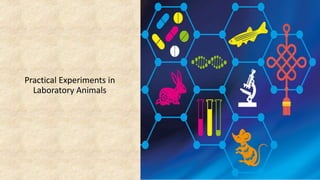This document provides an overview of the history and current use of laboratory animals in experimental research and medical testing. Some key points:
- Animal experimentation in medicine dates back to ancient Greece with Aristotle and Hippocrates dissecting animals. Galen in the 2nd century AD conducted early physiology experiments on pigs, monkeys and dogs.
- Today, around 75-100 million vertebrates are used annually worldwide for purposes like drug testing, vaccine testing, cancer research, and fundamental biological research. Common laboratory animals discussed include rats, mice, guinea pigs, hamsters, and others.
- These animals are used as they share biological similarities to humans and can serve as models for human diseases. Animal































































